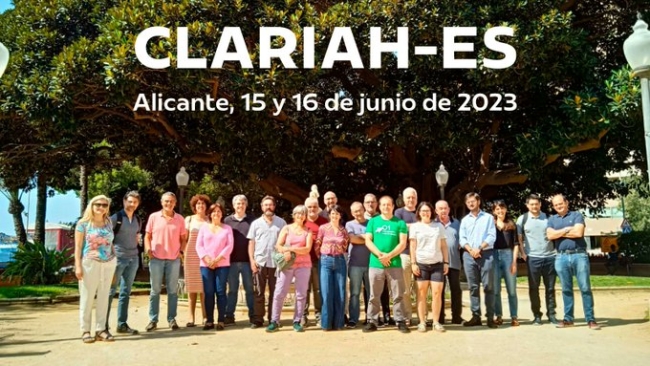We are pleased to announce that Spain will join CLARIN as full member starting 1 September 2023. Welcome!
About
Following the example of similar successful initiatives in other European countries, the INTELE strategic network (2020-2022) articulated and agreed on a common proposal for the CLARIAH-ES national consortium: to ask for the official integration of Spain into both CLARIN and DARIAH research infrastructures. The CLARIAH-ES proposal has the support of more than 750 researchers from 150 research groups from 35 universities and 65 institutions and research centers.

CLARIAH-ES is made up of a multidisciplinary group of computer science experts in Language Technologies (LT), Artificial Intelligence (AI), High Performance Computing (HPC), linguistic experts in, among others, the co-official languages of Spain (Spanish, Catalan, Basque, and Galician), and experts in digital transition in Social Sciences and Humanities (SSH), and the Arts.. Each of these groups brings together methodological expertise and key pieces of technology, knowledge, and information intended to create the distributed research infrastructure required to successfully deliver this initiative. The ambitious objectives of CLARIAH-ES can only be achieved by gathering the necessary resources in terms of data, computing facilities and knowledge that are generally not available to single research groups in Spain. The CLARIAH-ES infrastructure brings together researchers from 10 leading research centers in LT, AI, HPC, SSH, and at main libraries on Spanish and Ibero-American written, graphic and audiovisual culture.

The current CLARIAH-ES consortium is made up of the following 10 leading centers: UPV/EHU (HiTZ), Spanish National Research Agency CSIC (through Centro de Ciencias Humanas y Sociales), University of Santiago de Compostela (Instituto da Lingua Galega and CiTIUS), University of Alicante (Cervantes Virtual Library), UNED (LENAR and LINDH), BSC, Complutense University of Madrid (UCM), University of Jaén (CEATIC), ULPGC (IATEXT), and the National Library of Spain (BNE).
The participants of the national CLARIAH-ES consortium have been working with CLARIN and DARIAH for years (see Spanish CLARIN K-centre, IMPACT CLARIN-K and DARIAH Cooperating Partner) and the joint proposal will increase the visibility of the infrastructures and improve operability.
German Rigau from HiTZ has been appointed as the Spanish National Coordinator.
Objectives
CLARIAH-ES’ general objective is to coordinate the creation, development and dissemination of the infrastructure in order to contribute to the advancement of Spanish research in SSH and the Arts, as well as its strategic positioning in national and international projects and programmes, mainly in the context of the European Research Area.
The more specific objectives of the CLARIAH-ES strategic network are to coordinate, develop and disseminate the activities of the participating centers in the network in order to:
- Manage and coordinate CLARIAH-ES
- Understand the needs of researchers, groups and projects that need the support of content, tools and digital resources
- Design and coordinate the CLARIAH-ES infrastructure and its relationship with ERICs CLARIN and DARIAH
- Promote and facilitate the participation in the infrastructure of the research communities that are working in SSH and the Arts
- Promote and facilitate the use of both European CLARIN and DARIAH infrastructures
- Produce an annual report on the progress in the design and evaluation of the CLARIAH-ES infrastructure
- Participation in annual meetings, workshops and conferences organised by CLARIN and DARIAH
- Annual organisation of workshops on research that can be carried out thanks to the services, resources and tools of the research infrastructures in SSH and the Arts
- Establish a strategic communication plan, focusing on an impact and visibility in different areas and for different communities and types of users.